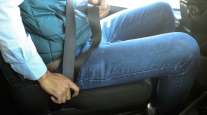Staff Reporter
Broken Lights Top Violation for North American Truckers

[Stay on top of transportation news: Get TTNews in your inbox.]
Inoperable vehicle lamps caused the most violations in national roadside inspections of trucks from the United States, Mexico and Canada last year, according to Federal Motor Carrier Safety Administration statistics.
In 243,159 roadside truck inspections last year, inoperable required-lamp violations were the single leading cause with 11.75% (344,225 violations) out of 404 types recorded.
There were specific numbers included for each nation:
- U.S. trucks — 300,433 violations (11.78%) in 212,256 inspections.
- Mexican trucks — 40,235 violations (11.72%) in 27,963 inspections.
- Canadian trucks — 3,269 violations (9.57%) in 2,768 inspections.
“It’s important to note, commercial motor vehicles coming in from Mexico are checked regularly as they cross the border and generally have better lighting compliance,” said Ericka Miller, press secretary with the Texas Department of Public Safety.
Although U.S., Mexican and Canadian trucks could have been cited for a variety of potential violations, they all had the highest numbers for inoperable lamps last year.
“Obviously, lights are important. They can go out at any time,” said Kerri Wirachowsky, director of the Roadside Inspection Program at the Commercial Vehicle Safety Alliance. “Some lights are critical, such as brake lights and tail lights, and can cause a vehicle to be placed out of service. Some are not, like license-plate lighting.”

Wirachowsky
The second-highest violation last year from all three countries was inoperable turn signal lights, according to FMCSA data.
Other top violations were inoperable head lamps, inoperable brake lamps and inoperable tail lamps, the agency said.
“Lamps such as brake lamps, head lamps and turn signals prevent crashes, especially at night. Lighting provides visibility and assists in signaling the vehicle movements or driver intentions,” said Lt. Bill Miller, public information officer with the Tennessee Highway Patrol.
He said inoperable truck lamps are a constant issue for commercial vehicles. “As vehicles are traveling, parts wear. The rougher the roadways, the more the stress on the vehicle components.”
Franka Young, of the Georgia Department of Public Safety’s Information Office, said, “All lights are essential; for example, a side-marker lamp on a trailer can warn another vehicle that a trailer is next to them in the dark.”
A common practice among drivers that leads to lamp violations is linked to LED lighting, found in most commercial trucks built within the last five years, Wirachowsky said.
“For drivers doing their truck inspections, LED lights are their friends. LEDs don’t all go out at the same time, unless a plug falls out, because they are clusters of diodes,” she added. However, many truck drivers typically wait for batches of LED lights to stop working instead of regularly replacing individual diodes, Wirachowsky said.
“I’m often asked, ‘How many diodes should be out before you fix them?’ ” said Wirachowsky. “I say, ‘As soon as you find any out, fix them and maintain the truck.’ ”
Ray Hasting, director of national accounts for Mack Trucks, agreed that drivers typically wait until several diodes fail before replacing LEDs, which have a 10-year life, even though replacing LEDs on the road is easy.
Hasting said most commercial truck owners, especially for highway fleets, use LED head lamps, tail lamps and marker lights despite a higher upfront cost than incandescent lamps because LED diodes last longer, need less voltage, operate at lower temperatures and are more resistant to shock and vibration.

Host Seth Clevenger, fresh from CES, discusses autonomous and electric trucks with Joe Adams of Kenworth and Cheng Lu of TuSimple. Hear a snippet above, and get the full program by going to RoadSigns.TTNews.com.
Another reason for the high rate of lamp violations is that they are easily and quickly found during walk-around inspections, Wirachowsky said.
Of all the U.S. commercial vehicle inspections (truck and bus) in general last year, the states with the most were: California (282,453 — 21% of the U.S. total), Texas (204,336 — 15%), New York (57,344 — 4%), Maryland (53,149 — 4%), North Carolina (48,568 — 3%) and Florida (40,872 — 3%).
Those with the least were Wyoming (3,615), Vermont (3,542), Alaska (2,659), Rhode Island (1,914), District of Columbia (1,703), and Hawaii (707).
Want more news? Listen to today's daily briefing below or go here for more info:




